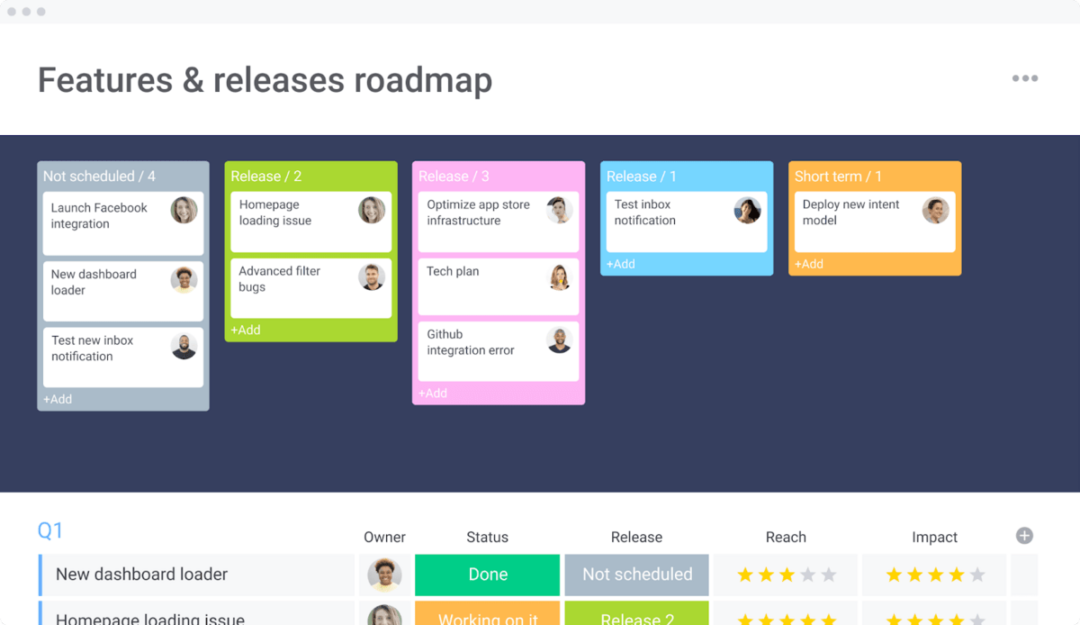What is the strategic management process?
Blog: Monday Project Management Blog
If you’ve been in management for a while, you might have heard someone claim that Sun Tzu’s The Art of War is a corporate leadership manual.
It seems ridiculous on the surface. The Art of War is about leading troops in battle, not directing resources to get work done.
But are those 2 things really that different?
Management and war have one thing in common: you need a success strategy. You can’t just react to events.
With the right tools and the proper approach, you can build an airtight strategic management process. This article will show you how.
What is the strategic management process?
Strategic management is the philosophy that the higher a manager is placed in a company structure, the farther ahead they should be looking.
A project manager shouldn’t just know what the next step is. They should know every step that leads to completion and beyond.
A department head shouldn’t just know what their teams contribute to the company. They should know how that value will change and evolve and what to do about it.
By the time you reach VP level, executives should be constantly looking down the road the entire organization travels on.
The business that wins out over its competitors is the one that’s best able to anticipate shifting market trends and innovate in response. A high-level strategic management plan enables your business to keep growing no matter how the environment changes around it.
The benefits of a successful strategic plan go well beyond profit.
With a clear plan, your employees will be more committed, and everyone down to the last individual contributor will learn to pull in sync. That makes your company more nimble and more durable, even if the future doesn’t go exactly as you planned.
So what is the strategic management process?
Unlike, say, building an Agile Scrum process, there’s no pre-set checklist for strategic management. Each organization’s strategic management process will look different. Building an effective one demands an intimate knowledge of your company.
By way of example, let’s examine a high-level project roadmap. The following is based on the features and releases template from monday.com.

This strategic management plan is relatively small-scale. It only concerns one project, and only lasts for a quarter. But it illustrates what strategic management can look like at every level.
The team has a clear goal: eliminate major bugs while simultaneously releasing new quality-of-life features.
By rating the reach and impact of each task, the whole team is encouraged to align their methods to their goals.
What are the components of strategic management?
The strategic management process is about understanding where you are, where you’re going, and why your company does what it does.
There’s no cheat code for a solid grasp of your position, direction, and values. It comes down to a few hard decisions, a ton of research, and a lot of confidence in your strategy implementation.
To build a strategy that works, your best bet is to follow 4 fundamental steps: understand, decide, implement, and revise.
If you follow the 4 steps properly, you’ll end up with a strategic plan that increases the cohesion and efficiency of your team.
And there’s some good news: while there are no shortcuts, there is technology you can use to make strategic planning easy — even fun.
Understand your environment
Gathering information is the first step in the strategic planning process. But there’s also what some might call “step zero”: having a clear vision to start with.
That might sound weird — isn’t the whole purpose of this process to build your organization’s vision?
Not quite. Strategic management is about drawing a roadmap to get where you’re going. But a vision can’t be instilled artificially. It has to come from your business’s DNA.
What was your original mission statement? Why does your team or company exist? Is it to turn a profit? To solve a problem? To lead the way to the future? Or a combination of all those things and more?
Remember the old saying: “if you don’t have a destination, no wind is favorable.”
Once you understand where you’re going, you can start gathering information about where you are. Your roadmap needs both a destination and a starting point. The best way to predict the future is to gather plenty of information about the present.
Understanding your environment requires gathering trustworthy information on several dimensions of your business. Broadly, you’re looking for any facts and data that relate to your business goals.
This might include an external analysis, where you research the environment outside your company.
The external strategic analysis answers questions like:
- Who is our competition?
- What is our main competitive advantage?
- Is our industry growing, shrinking, or evolving?
- What external factors influence our industry — government policies, shifts in public opinion, broad socio-economic trends, etc.?
- Are we competitive on the world stage? Do we want to be?
By contrast, an internal analysis is about looking inward.
It addresses questions like:
- How do our team members interact with each other? Superiors? Inferiors? Is anything in our culture hindering innovation?
- Does our organizational structure meet our needs?
- Are we being stifled by waste, legacy processes, or organizational debt?
- What is our relationship with our customers? Does everything we do ultimately create value for them?
The internal analysis is one of the first steps in the strategic planning process where the right technology can be a huge help. Take the monday.com employee engagement survey as an example.
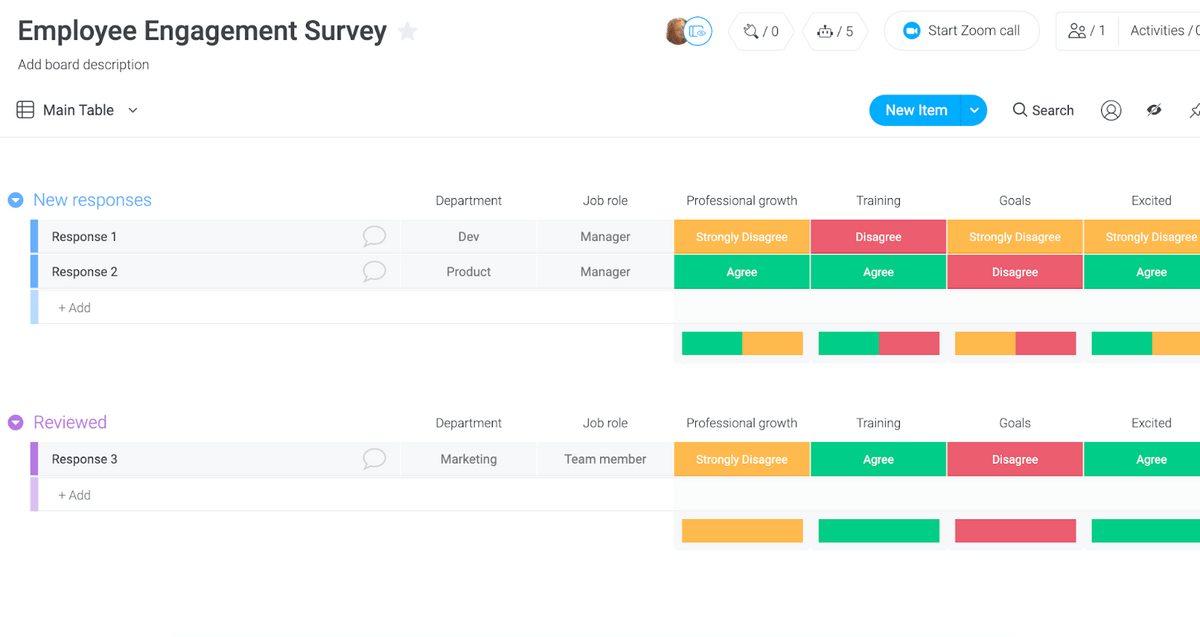
By creating and sharing a simple form, you can ask your employees questions that have huge implications for how you reach your goals.
Their survey responses update the table automatically, bringing you information in real-time.
Decide on a strategy
Your next step, based on what you learned from your environmental scanning, is to update your high-level vision. This is called strategy formulation.
For example, plenty of startups have launched an exciting new technology, only to learn they can get better product-market fit by applying it another way — or pivoting to a whole new technology.
Never forget that Netflix was founded to mail DVDs to people. Your original strategic objective can still be a guideline. You’re just updating it to fit new information.
Start this step by quantifying your original goals numerically. For example, if your strategic goal was to become the dominant SaaS helpdesk in the market, you could quantify that as a 10% market share.
Again, use technology to help you along the way. monday.com can be used to build a KPI dashboard that integrates with your data from the previous step.
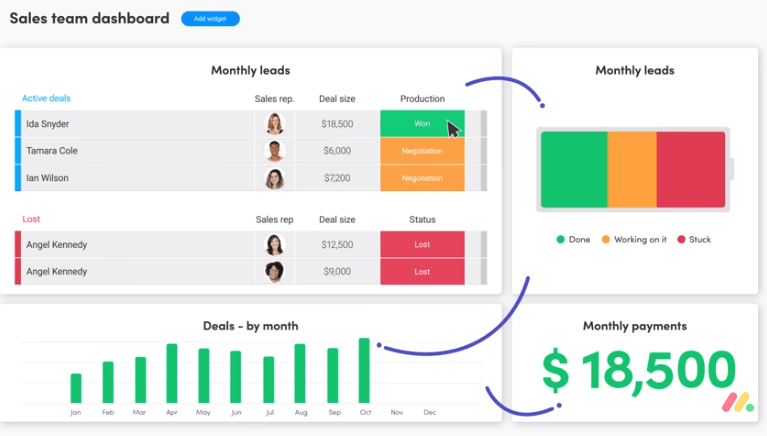
The dashboard above focuses on how the sales team contributes to the company’s overall goals. But it could be customized for any team.
When you have your vision quantified, ask yourself if your team has the resources needed to reach those numbers.
If the answer is no, you can either redirect resources, change your goals, or both.
Before deciding to change your goals, run a detailed analysis of your processes. You might have the resources you need already, but not be using them as efficiently as possible. If that’s the case, you could reach your original vision after all.
That’s all a strategic plan is: a way to close the gap between your current performance and the performance you want. Once you see the way between those 2 points, you’ve got your plan.
Implement your strategic plan
Your roadmap is ready — now it’s time to start driving.
In this step, boldly implement the plan you’ve decided on. You can and will change it — see the next step — but for now, your whole team, division, or company needs to be committed to the current course.
No matter the scale you’re working on, success here is basically like managing a large, complex project: it comes down to building structures, directing resources, and continuous monitoring.
That makes the monday.com advanced project management template a useful tool.
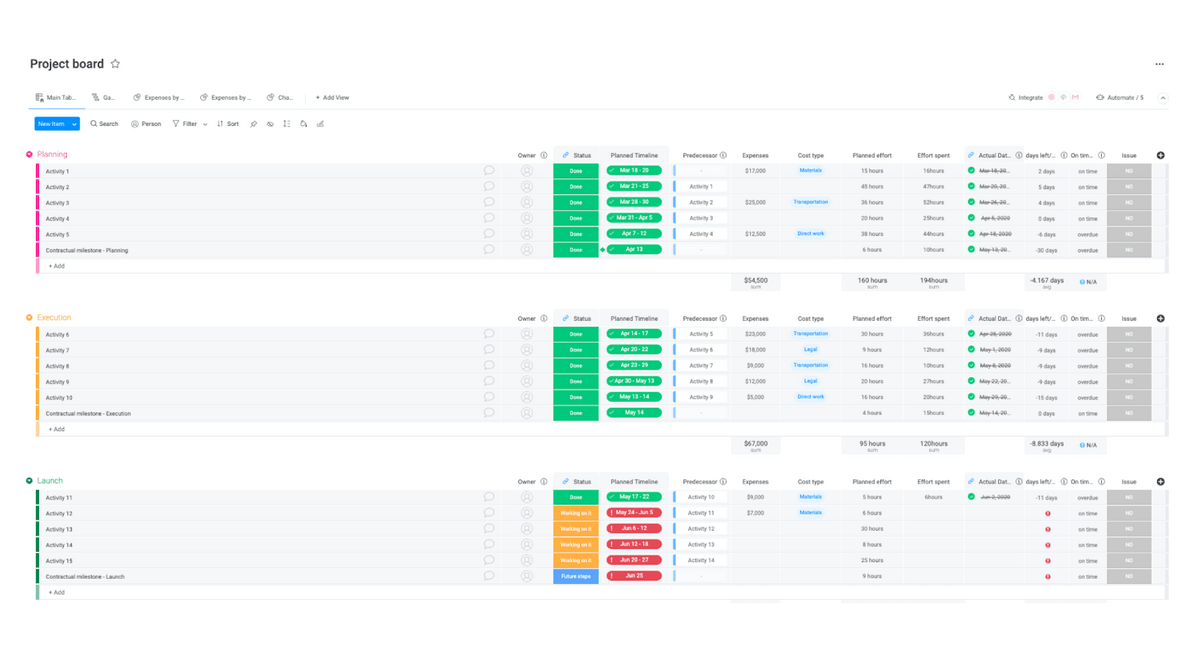
Don’t let that image intimidate you. High-level strategy implementation is a matter of 2 factors: good policies, and good information.
Good information is the easy part. That complex table above is actually an automated dashboard that’s constantly gathering data on how close you are to achieving your key performance indicators (KPIs).
Building the right policies is harder because it gets down to the very bones of your organization. You have to build a company that’s capable of following your strategic plan. Anything that doesn’t fit needs to be adjusted.
You need:
- Mechanisms to distribute resources where they’re most needed
- Clear lines of communication that can resolve any blockages
- Obvious rewards for following the strategic plan, and corrective actions for straying
- Leaders who understand and enthusiastically support the strategic plan
- Crisis management policies
Once you’ve got this structure in place, you’re still not finished. The final step might be the most important of all.
Constantly re-evaluate
If you thought you could build a high-level strategy once and then check out, we’ve got bad news. The strategic management process never really stops.
Think about it this way: what happens to a company that commits so rigidly to a single plan that it can’t change course?
It’s often the same thing that happens to businesses that don’t build a high-level strategy at all.
As you work through your strategy implementation, use KPIs to appraise how well it’s going.
If you’re doing well in one area but not others, figure out why that one area is working, and how it can be adapted to the whole plan. If that conflicts with existing policies, cut them — they’re waste at this point.
The monday.com A/B testing and planning template can help a lot with strategy evaluation.
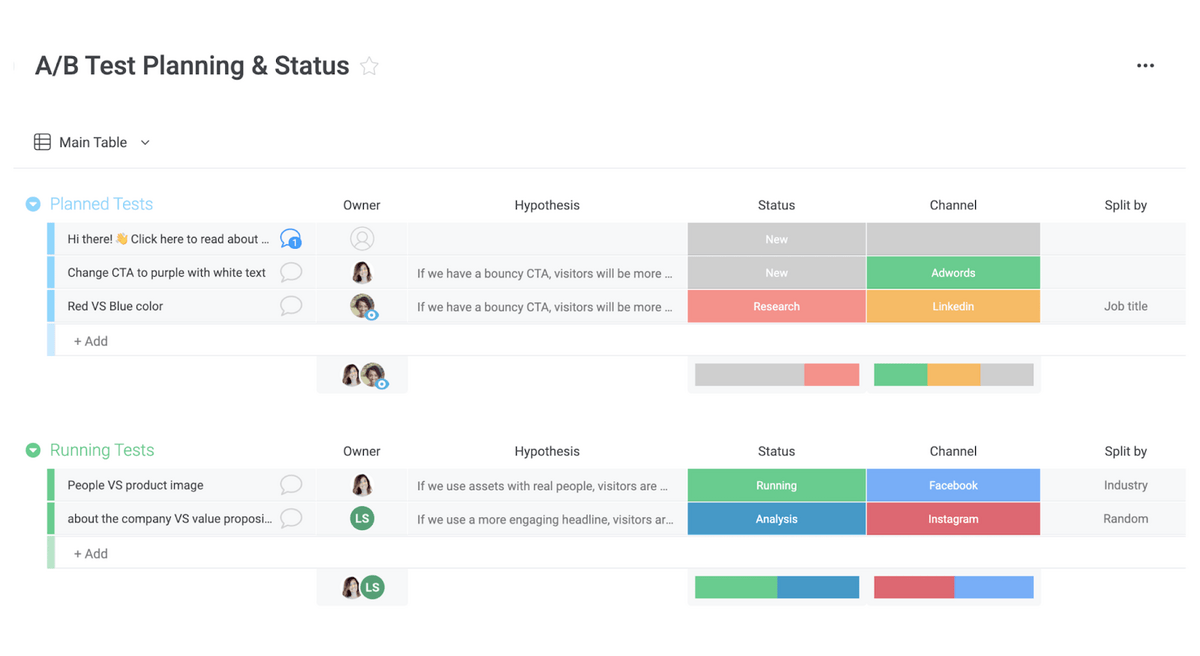
Lots of users apply this template to products, but it also works for strategies. Document how you’re regularly evaluating your strategic approach, and what you’ve chosen to adjust based on those evaluations.
One great thing about monday.com dashboards is that they can easily be shared with and read by everyone in your organization. The criteria you’re using to assess and adjust your strategy will be transparent to everyone — making it that much easier to get everyone on board.
What is the best strategic tool?
We’ve featured several monday.com products over the course of this article, but we’d like to explain in even more detail why we think it’s the best tool for the strategic management process.
monday.com can be used to create something we like to call a Work OS. It starts with visually pleasing, freely customizable templates, then links those templates together with automated workflows.
It also integrates with your favorite software outside of monday.com, like Dropbox, Slack, and Microsoft Teams.
monday.com gives you all the tools you need to build a Work OS that fits the unique way you do business. A well-built Work OS saves your employees time, makes sure everybody constantly has complete information, and helps everyone unify around a big-picture strategy.
Create your strategic management process
There’s no manual to tell you exactly how to build a strategy for your team, but the steps above are a great way to start.
Begin by understanding your vision, then studying your environment. Build a long-term goal that works, come up with strategies to help you get there, and implement them boldly.
As you go, make sure you’re working with the best strategic management technology.
If you’re ready to be more strategic, contact monday.com for a demo right now.
The post What is the strategic management process? appeared first on monday.com Blog.
Leave a Comment
You must be logged in to post a comment.
